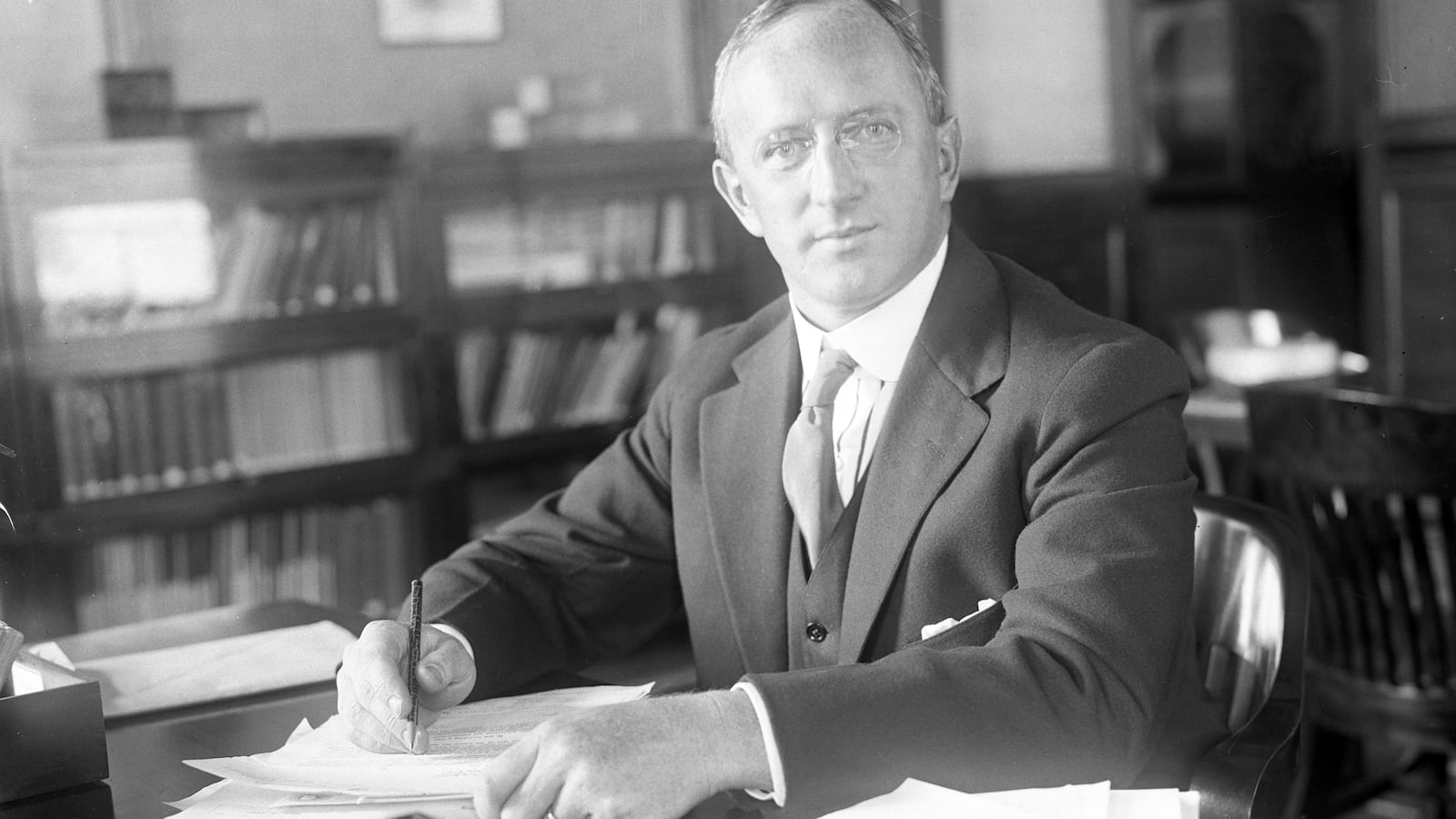The Holland Tunnel, which stresses out many of the 35 million drivers who pass through it annually, has nothing to do with the Dutch and everything to do with a health warning: Beware, all that stress might kill you.
The Tunnel, which opened on Nov. 13, 1927, commemorates the engineer who designed it, Clifford Holland. He achieved immortality because he did not live to see his great creation. Only 41, he died on Oct. 27, 1924—crushed by the kind of tension his tunnel now mass-produces.
In fairness, his were the grand worries of the Master Builder, trying to engineer a new approach to an ancient problem: How can humans cross the river? Approximately 20,000 commuters ferried between New Jersey and New York daily. The trip was long—and the lines to get onto the ferries, longer. Moving freight was expensive and unreliable. When the river iced over, Manhattan was isolated. After New Yorkers could not get coal for heating during the harsh winter of 1917 to 1918, much of the opposition to the proposed tunnel finally melted away.
Yet people remained skeptical. Imagining a “Highway under the Hudson” was hard enough. Train tunnels proved it was possible, although the river’s width required building the world’s longest underground crossing as of 1927. Wondering how to manage 3,800 cars spitting onto Manhattan’s already congested streets hourly was complicated enough. But the biggest obstacle was environmental. Once you dug a hole and protected it from rushing water, trains could cross easily because they were relatively clean. Cars belched out carbon monoxide. Initial estimates calculated that by the time drivers crossed the 9,250-foot tunnel, the poisons their car generated would kill them.
The go-to-guy for under-the-Hudson tunneling, Clifford Milburn Holland, had already designed subway tunnels. But the pollution problem was a pickle. Born in 1883, in Somerset, Massachusetts, Holland graduated from Harvard College, class of 1905, when it was WASP U. A year later, he received his B.S. in engineering there. He married Anna Coolidge Davenport in 1908. She would outlive him by 49 years—dying at the age of 88 in 1973.
Donald Trump take note—a great nation doesn’t proclaim itself great, it rolls up its collective sleeves and gets to work. New York’s post-Civil War surge of infrastructure building had left a legacy of great public works culminating in the Brooklyn Bridge, tainted by great corruption epitomized by the gluttonous Boss William M. Tweed. Now, following “the Great War,” motivated by Progressive optimism, New York was adapting to that transformational 20th-century invention, the motor car.
Commuting emerged as a concept before the Civil War—when regular train travelers had their ticket prices commuted—cut—to encourage loyal patronage. The concept of Metropolitan Areas was emerging as transportation arteries interconnected once distant areas—statisticians only invented the term in the 1950s.
Despite being afflicted with a weak heart, Holland started as a loyal soldier advancing this march of progress. He honed his expertise constructing subway tunnels, including the 14th Street Tunnel.
These practice runs proved important. Building what was called the Hudson River Vehicular Tunnel or the Canal Street Tunnel would be his reputation-defining—or crushing—marathon. Since 1906 a group of idealistic commissioners working for the New York State Bridge and Tunnel Commission had been pushing this idea with partners in the New Jersey Interstate Bridge and Tunnel Commission. Often paying for office help and supplies personally, four original New York commissioners ultimately would earn praise from The New York Times, which claimed that “never before have the original members of a commission remained in the same office for practically twenty years.”
In 1919, with momentum building and public opinion shifting, the commissioners appointed the 36-year-old Holland chief engineer of what would end up being a $48.5 million project. In February 1920, the Brooklyn Daily Eagle marveled: “When Clifford M. Holland talks tunnels, his listener is in danger of being convinced that tunnels are the only refuge for mankind.” Reporters christened him “the Head Mole.”
Solving the ventilation problem would require digging even deeper—intellectually. Eventually, he and his design engineer Ole Singstad performed over 2,000 experiments, and established the industry standard. While burrowing deep under the Hudson, they also built four six-story structures towering over it. These behemoths contained 84 fans—some eight feet across—that sucked the air out of the tunnel. With the air renewed every 90 seconds, the tunnel’s air quality was better than Manhattan’s.
Alas, by then, Holland was dead. The politics wasn’t easy. The “sandhogs” started digging in secret on March 31, 1922, surprising Jersey City residents worried about traffic overwhelming them. The tunneling was dangerous. Entering and exiting the tunnels required deep-sea-diver-level compression and decompression procedures, which probably exacerbated Holland’s heart troubles. And the pressure to complete was intense.
Anna Holland later said: “If I had known it was sapping his strength so much, I would have urged him to be more careful, but he was so completely wrapped up in his work that I really do not know if my pleadings would have had any effect.”
In 1924, President Calvin Coolidge was set to detonate the explosion for “holing through” on Oct. 28. For two years two crews had been tunneling toward each other, from Jersey and Manhattan. That blast would unite them at midpoint. Shortly before this presidential ceremony, Holland cracked. Suffering from “nervous exhaustion,” he checked himself into a Battle Creek, Michigan sanitarium. On Oct. 24, his heart stopped. His death at 41 was so shocking the commissioners postponed the October festivities—then named the tunnel after him on Nov. 12, 1924.
The gods still demanded more from this project. Holland’s successor Milton Harvey Freeman, died in March 1925 of pneumonia. The New York entrance to the Holland Tunnel, Freeman Plaza, honors him.
The Holland Tunnel finally opened on Nov. 13, 1927. Hailed as the Eighth Wonder of the the world, its two, two lane 1.6 miles long tubes rest as low as 93 feet below the water level.
At 4:55 p.m. on Nov. 13, 1927, President Coolidge, moored on the presidential yacht, the Mayflower, in the Potomac River, used the golden telegraph key President Woodrow Wilson had used to open the Panama Canal. This time, the key triggered a current to draw American flags hanging front of the tunnel entrances on the New Jersey and New York sides. Gov. Al Smith of New York celebrated “the wedding” of his state with New Jersey. Twenty thousand curious pedestrians marched through the tunnel over the next two hours. At one minute after midnight, cars started crossing. In the second car, paying the first toll with 1927 mint dollars, were the widows Holland and Freeman. Within 24 hours, 51,694 vehicles had paid the 50-cent toll.
Clifford Holland had “died in harness, absorbed in problems that fascinated him,” The New York Times wrote. “His genius brooded over all, over the laboratories where his questions in chemistry and physiology were answered, over the drafting board, over the sand hogs in the shields under the river… Engineering has nothing finer to offer than the spirit of scientific inquiry that governed Holland and his successors at every step.” In commemorating the opening of his tunnel, “one of the engineering triumphs of America,” we hail Holland’s precision, his search for truth, his ability to get things done. But, most of all, we hail his and his peers’ vision, their confidence that they could imagine a better future—and make it happen. That, after all, was the American way—then, but now too.
FOR FURTHER READING
Angus Kress Gillespie, Crossing Under the Hudson: The Story of the Holland and Lincoln Tunnels, 2011.
Keri Blakinger, “Spanning the decades: A look at the history of New York City’s tunnels and bridges,” 2016.
Robert W. Jackson, Highway Under the Hudson: A History of the Holland Tunnel, 2011.





